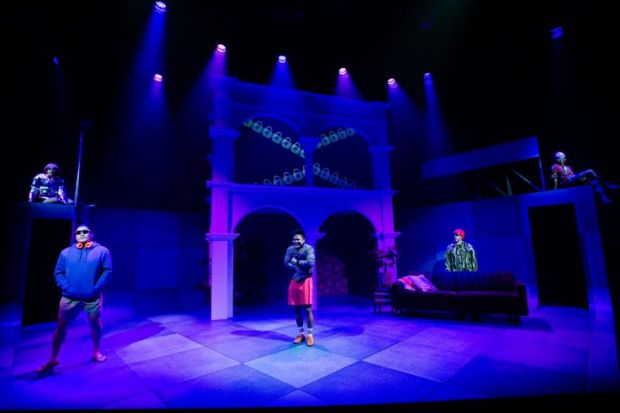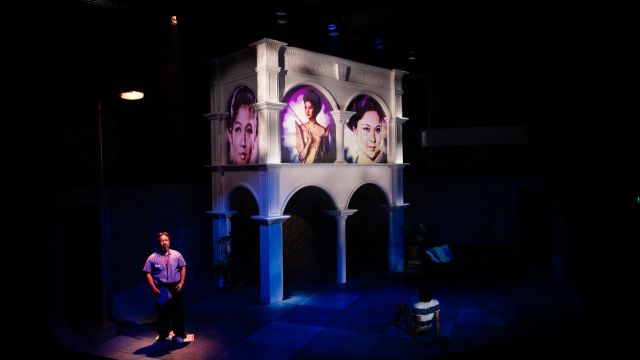Malacañang Made Us
There’s something thrilling about witnessing a world premiere that’s already earned its accolades before opening night. In the case of Malacañang Made Us, winner of the Queensland Premier’s Drama Award 2025, the pre-show buzz was justified. What unfolded on the stage of the Bille Brown Theatre was a work of intelligence, heart, and finely tuned theatrical craft.
Set between 1986 Manila and present-day Brisbane, the play examines how the aftershocks of dictatorship ripple through generations. It follows brothers Martin and Ernie, who, as young men, stormed the palace of Ferdinand Marcos during his fall from power, and decades later find themselves revisiting those choices through the eyes of Martin’s son, Leo. Through the lens of this history and the ripple effects of their choices, the play explores themes of legacy, duty, and identity. Yet it doesn’t feel horribly draining, as the tale is wrapped in warmth, humour, and an unforgettable plot twist that quite literally makes the audience gasp.

Shea’s script is remarkably well-balanced; it’s politically charged without being didactic, poetic yet grounded, historically detailed but never weighed down by exposition. The writing dances between timelines with deftness, using memories and digital conversations as mirrors of each other. The imagery in the flashbacks often verges on the lyrical; moments of revolution and reflection are described in language that feels like poetry. Shea’s command of tone ensures that even amidst political upheaval and personal grief, there’s real, generous, human laughter that punctures tension rather than dilutes it.
Director Kenneth Moraleda approaches the material with a confident hand and an impeccable sense of rhythm. The interplay between past and present could easily have become chaotic, yet under Moraleda’s direction it feels fluid and intentional. His use of physical levels and spatial relationships is particularly striking. I love the moments where the past literally engages with the present.
Also effective, are the moments where digital avatars overlap with memory and become visual metaphors for generational inheritance. The pacing is taut without feeling rushed, allowing space for the emotional crescendos to land fully. Moraleda also coaxes some exceptional performances from his ensemble, each actor sharply defined yet harmoniously connected.
Mark Paguio’s Leo is the beating heart of the production; a young man straddling two histories and struggling to forge his own. Paguio’s stage presence and emotional transparency make him instantly sympathetic, and his quieter moments carry as much power as his passionate outbursts.
As Ernie, Marcus Rivera is a charismatic force, balancing humour and heartbreak with great precision. His physicality and comic timing are immaculate, but it is his emotional believability that makes Ernie’s arc so affecting. Marty Alix as Young Ernie (and online persona @Bunsoybby) shows a beautifully focused, lyrical energy. Alix’s ability to pivot between sensitivity and high-octane hilarity gives his dual roles a vibrant, unpredictable charm.
Miguel Usares brings subtle vulnerability to Young Martin and an infectious vitality to @SisigKween. His performance is measured, intelligent, and deeply physical — a careful balance of bravado and fragility. As the older Martin and his digital alter-ego @NotaNurse03, Mike Zarate delivers a performance marked by expressive nuance and emotional honesty. Zarate’s work is particularly moving in the quieter, anxious beats of Martin’s story, while his comedic turns as @NotaNurse03 showcase his range and impeccable timing. Each performer’s role — some anchored in history, others in the hyperactive online present — is delineated with clarity and flair, and the chemistry among the ensemble gives the play a living pulse.

Set and Costume Designer Jeremy Allen meets the play’s complexity with a conceptually rich, visually satisfying solution. The mash-up of locations including the streets of Manila, Malacañang Palace, King George Square, a Brisbane living room, and a digital chat space all coexist within one cohesive structure, layered but never cluttered. The vivid colours and textures bring warmth and life, while the costumes subtly reflect each character’s personal evolution. The costuming of the younger, online-savvy characters is particularly sharp, playful, expressive, and instantly recognisable to a modern audience.
Lighting Designer Christine Felmingham faces the formidable task of illuminating a large white structure without washing it out, and she handles it with remarkable sensitivity. Her lighting sculpts mood and atmosphere with precision, moving seamlessly between memory and immediacy. Video Designer Nevin Howell’s contribution is indispensable. His projections achieve more than decorating the action; they tell the story. From contextualising the historical moments to amplifying the tension of revolution scenes, the video design is both narrative and emotional scaffolding. Together, the visual and technical elements create a layered, immersive world where the digital and the human coexist.
Malacañang Made Us is that rare thing: a politically engaging work that feels alive, funny, and deeply personal. It’s as thrilling as it is moving, bridging continents and generations while holding a mirror up to Australia’s own multicultural identity. Jordan Shea’s writing is confident and compassionate; Kenneth Moraleda’s direction, inventive and assured; and the cast’s performances, simply outstanding.

It’s no wonder this play earned the Queensland Premier’s Drama Award before it ever met an audience! The reward now is ours: a reminder that rebellion, family, and love are all acts of courage, and that history is never as far behind us as we might like to think.
Kitty Goodall
Photography by Morgan Roberts
Subscribe to our E-Newsletter, buy our latest print edition or find a Performing Arts book at Book Nook.

